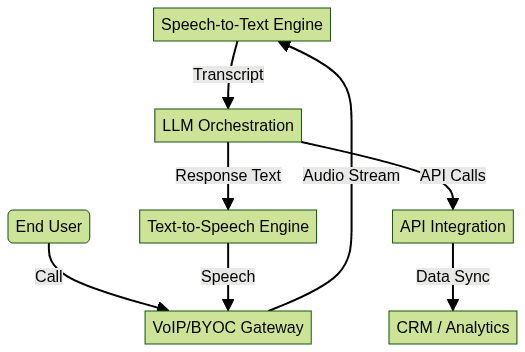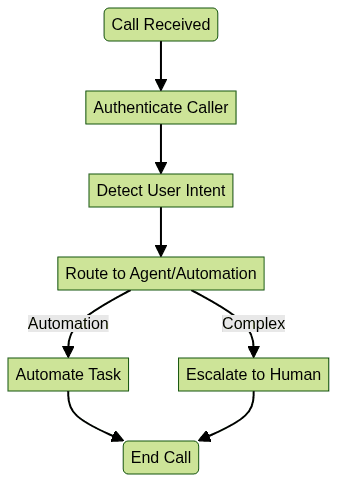Introduction to AI Voice Agent Platforms
AI voice agent platforms are transforming how businesses interact with customers in 2025. These platforms harness conversational AI, voice AI agents, and advanced voicebot technology to automate and personalize customer support at scale. By integrating speech-to-text (STT), text-to-speech (TTS), and large language model (LLM) orchestration, organizations can deliver seamless, hyper-realistic voice experiences.
The growing importance of AI voice agent platforms is evident in sectors like contact center automation, e-commerce, healthcare, and hospitality. With real-time voice AI capabilities, these platforms enable efficient, multilingual support, reduce operational costs, and ensure consistent user experiences. Leveraging VoIP integration, bring your own carrier (BYOC) options, and robust API integration, businesses can deploy and manage scalable, compliant, and developer-friendly voicebot solutions. This guide explores the architecture, key features, deployment strategies, and future trends shaping the AI voice agent platform landscape in 2025.
How AI Voice Agent Platforms Work
Modern AI voice agent platforms comprise several core components:
- Speech-to-Text (STT): Converts spoken input into text, enabling natural language understanding.
- Text-to-Speech (TTS): Generates lifelike, hyper-realistic voices for dynamic, real-time responses.
- LLM Orchestration: Coordinates large language models and business logic to ensure contextually relevant, adaptive conversations.
These platforms seamlessly integrate with existing telephony infrastructure through VoIP and BYOC models, allowing organizations to leverage their preferred carriers and SIP trunks. API integration ensures connectivity with CRMs, analytics, and workflow automation tools, enabling end-to-end customer support automation. For developers looking to add real-time audio capabilities, integrating a
Voice SDK
can streamline the process and enhance platform flexibility.
This architecture ensures real-time voice AI experiences, robust workflow integration, and knowledge integration for scalable customer operations.
Key Features of Leading AI Voice Agent Platforms
Hyper-Realistic Conversational AI
Top AI voice agent platforms deliver hyper-realistic voices using advanced TTS models and voice synthesis. Features like dynamic turn-taking, low latency, and context-aware responses ensure natural, engaging conversations. These platforms leverage neural TTS and deep learning to mimic human prosody, intonation, and emotional nuance, driving increased customer satisfaction and trust. To further enhance conversational experiences, platforms often utilize a
Voice SDK
for seamless audio integration.Scalability and High Concurrency
A hallmark of a robust AI voice agent platform is its ability to handle thousands of concurrent voice sessions. Elastic infrastructure, containerized microservices, and distributed cloud architectures enable seamless scaling. High concurrency ensures consistent performance, even during peak demand, supporting global enterprise operations. For organizations seeking to support large-scale voice interactions or integrate calling features, exploring a reliable
phone call api
is essential.Multilingual and Global Support
Modern platforms support 30+ languages and dialects, including mid-call language switching. This multilingual capability empowers organizations to serve diverse, global audiences with real-time voice AI agents, breaking down language barriers and expanding market reach. Integrating a
Voice SDK
can further support multilingual audio features and enhance accessibility.Customization and Flexibility
Leading platforms offer developer tools, workflow automation, and scriptable logic for tailored voicebot experiences. Consider a simple Dashascript snippet for voice flow customization:
1start:
2 say("Hello! How can I assist you today?")
3 listen
4 goto processRequest
5
6processRequest:
7 // Custom logic based on user input
8 say("Let me check that for you.")
9 end
10This flexibility empowers developers to design unique, branded conversational experiences. For those looking to add video capabilities alongside voice, it's possible to
embed video calling sdk
solutions for a unified communication experience.Security and Compliance (SOC2, HIPAA, PCI)
Security and compliance are foundational for enterprise adoption. Platforms should offer end-to-end encryption, adherence to SOC2, HIPAA, and PCI standards, audit trails, and granular access controls to ensure data privacy and regulatory compliance across all customer interactions.
Implementation: Deploying Your First AI Voice Agent
Choosing the Right Platform
When selecting an AI voice agent platform, evaluate scalability, language support, ease of API integration, compliance certifications, and developer documentation. Consider platforms with proven customer support automation capabilities, BYOC flexibility, and robust analytics. If your use case involves integrating calling features into mobile apps, reviewing a
callkit tutorial
can be invaluable for iOS development.Step-by-Step Deployment Walkthrough
Let's walk through deploying a basic AI voice agent platform for customer support automation:
- Provision the Platform: Sign up and configure your voicebot platform with required STT/TTS engines and LLM orchestration.
- Integrate VoIP/BYOC: Connect your SIP trunk or VoIP carrier for inbound/outbound calls. For scalable telephony integration, consider leveraging a
phone call api
to streamline setup and management. - Configure Workflow: Script agent logic using platform tools or APIs.
- Deploy and Test: Run automated and manual tests for call flows, latency, and language accuracy.
- Go Live: Launch the AI agent for real customer interactions.
Example API integration for call initiation:
1import requests
2
3url = "https://api.example-voice-platform.com/start_call"
4payload = {
5 "to": "+1234567890",
6 "script_id": "customer_support_v1",
7 "language": "en-US"
8}
9headers = {
10 "Authorization": "Bearer YOUR_API_KEY"
11}
12
13response = requests.post(url, json=payload, headers=headers)
14print(response.json())
15Integrating with Existing Workflows
Modern voice AI platforms provide APIs and webhooks for seamless integration with CRMs, ticketing systems, analytics, and knowledge bases. This allows real-time data sync, advanced workflow automation, and actionable insights for continuous improvement. To add robust conferencing or video features, integrating a
Video Calling API
can further extend your platform's capabilities.Advanced Use Cases and Workflow Automation
Contact Center Automation
AI voice agent platforms enable end-to-end contact center automation—routing, authentication, FAQ handling, and escalations—reducing wait times and freeing up human agents for complex queries. Real-time voice AI agents operate 24/7, ensuring round-the-clock support and improved customer satisfaction. For enhanced audio experiences in live agent scenarios, a
Voice SDK
can be integrated to support high-quality, interactive voice sessions.E-commerce, Healthcare, and Hospitality
- E-commerce: Automate order tracking, returns, and product recommendations using voicebot platforms with LLM orchestration and real-time voice AI.
- Healthcare: Support appointment scheduling, prescription refills, and compliance (HIPAA) with secure, multilingual voice agents.
- Hospitality: Manage reservations, guest inquiries, and feedback with hyper-realistic conversational AI, enhancing guest experiences and operational efficiency.
Complex Workflow Orchestration
Advanced platforms offer workflow automation for multi-step, context-driven conversations.

This workflow demonstrates seamless orchestration between automated and live agent support.
Developer Tools and APIs
AI voice agent platforms in 2025 are API-native, offering developer-friendly SDKs, webhooks, and BYO (bring your own) model support. Features include:
- API Integration: Initiate calls, manage sessions, and control workflows programmatically. Developers can leverage a
Voice SDK
to quickly add real-time audio features to their applications. - Automated Testing: Simulate voice conversations, validate flows, and set up guardrails to ensure quality.
- BYO Models: Integrate custom LLMs or TTS/STT engines as needed.
Sample code to trigger a voice workflow via API:
1fetch("https://api.voicebotplatform.com/v1/calls", {
2 method: "POST",
3 headers: {
4 "Authorization": "Bearer YOUR_API_TOKEN",
5 "Content-Type": "application/json"
6 },
7 body: JSON.stringify({
8 to: "+19876543210",
9 workflow_id: "support_flow_2025"
10 })
11})
12 .then(response => response.json())
13 .then(data => console.log(data));
14Automated pipelines, guardrails, and real-time analytics empower developers to deliver robust, secure, and compliant solutions.
Future Trends in AI Voice Agent Platforms
The AI voice agent platform landscape is rapidly evolving in 2025. Expect:
- Real-Time AI Improvements: Faster, more accurate STT/TTS models for lifelike conversations.
- Increased Personalization: Contextual, knowledge-integrated responses tailored to each user.
- Tighter Compliance: Enhanced privacy controls, automated redaction, and continuous regulatory alignment (SOC2, HIPAA, PCI).
With ongoing advancements, AI voice agent platforms will continue to redefine how organizations automate and personalize customer engagement.
Conclusion
AI voice agent platforms are revolutionizing customer support, contact center automation, and workflow orchestration in 2025. With hyper-realistic conversational AI, high scalability, multilingual support, and robust compliance, these platforms are essential for digital transformation. Developers and enterprises should leverage these technologies to create seamless, secure, and scalable voice experiences that delight users and drive operational efficiency.
Try it for free
and start building your next-generation voicebot platform today.Want to level-up your learning? Subscribe now
Subscribe to our newsletter for more tech based insights
FAQ